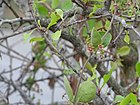Note: This is a project under development. The articles on this wiki are just being initiated and broadly incomplete. You can Help creating new pages.
Tylophora indica - Lataksiri
Lataksiri is a slender, hairy or glabrous branching climber, producing stems up to 1.5 metres tall from a short rhizome that is 3 - 4mm thick. The plant is used locally as a source of fibre and medicines. It is used in treating bronchial asthma and allergic rhinitis.
Uses
Parts Used
Chemical Composition
Common names
| Language | Common name |
|---|---|
| Kannada | aadu muttada balli, naayihaale, anthamoola, kirumani |
| Hindi | antamul, janglipikvan |
| Malayalam | vallippala, |
| Tamil | Nachchuruppam, nanjamurichchaaan, nayppalai, peyppalai, kondachani |
| Telugu | Verripaala, vettipaala, kaakpaala, kukkapala, tellayadala, tellavedavela, neelataapiri. |
| Marathi | NA |
| Gujarathi | NA |
| Punjabi | NA |
| Kashmiri | NA |
| Sanskrit | arkaparni, lataksiri, shwasaghni, anthrapachaka, gandhana, moolinee |
| English | Indian Ipecac |
Properties
Reference: Dravya - Substance, Rasa - Taste, Guna - Qualities, Veerya - Potency, Vipaka - Post-digesion effect, Karma - Pharmacological activity, Prabhava - Therepeutics.
Dravya
Rasa
Tikta (Bitter)
Guna
Laghu (Light), Rooksha (Dry)
Veerya
Sheeta (cold)
Vipaka
Madhura (Sweet)
Karma
Pitta, Vata
Prabhava
Habit
Identification
Leaf
| Kind | Shape | Feature |
|---|---|---|
| Simple | Opposite | 4-10 x 2-5.5 cm, ovate to oblong, acute or acuminate apex, base subcordate, entire, slightly pubescent on both sides, petiole to 0.8 cm. |
Flower
| Type | Size | Color and composition | Stamen | More information |
|---|---|---|---|---|
| Bisexual | umbellate cymes | greenish-purple or greenish-yellow | bracts filiform, hairy. Calyx hairy outside, divded nearly to the base, lobes linear-lanceolate, to 2 mm. Corolla 1 cm across, lobes to 4 mm long. Corona single, lobes acuminate at tip. Ovary ob-conical; style to 1 mm |
Fruit
| Type | Size | Mass | Appearance | Seeds | More information |
|---|---|---|---|---|---|
| Follicles | 7 - 10cm | oblong, tapering towards the apex, glabrous | seeds 7 mm long, broadly ovate, coma 2-2.5 cm long. | {{{6}}} |
Other features
List of Ayurvedic medicine in which the herb is used
Where to get the saplings
Mode of Propagation
How to plant/cultivate
The seeds have a high germination percentage (more than 90%) but fruit set is rare. Vegetative propagules as cuttings from stem coppices or ground layering can be prepared in spring season. [4]
Commonly seen growing in areas
Photo Gallery
References
- ↑ [1]
- ↑ Vernacular names
- ↑ Botonic description
- ↑ Cite error: Invalid
<ref>tag; no text was provided for refs namedCultivation
External Links
- Pages with reference errors
- Ayurvedic Herbs known to be helpful to treat Arthritis
- Ayurvedic Herbs known to be helpful to treat Sinusitis
- Ayurvedic Herbs known to be helpful to treat Respiratory infection
- Ayurvedic Herbs known to be helpful to treat fever
- Ayurvedic Herbs known to be helpful to treat Asthma
- Ayurvedic Herbs known to be helpful to treat Autoimmune disorders
- Herbs with Root used in medicine
- Herbs with Leaves used in medicine
- Herbs with common name in Kannada
- Herbs with common name in Hindi
- Herbs with common name in Malayalam
- Herbs with common name in Tamil
- Herbs with common name in Telugu
- Herbs with common name in Sanskrit
- Herbs with common name in English
- Habit - Climber
- Index of Plants which can be propagated by Seeds
- Index of Plants which can be propagated by Cuttings
- Herbs that are commonly seen in the region of Tropical area
- Herbs
- Ayurvedic herbs that don't have flower, fruit and leaf photos
- Ayurvedic herbs that don't have seed photos
- Apocynaceae




